SCICEX 99 Article from Professional Mariner #51
Punching through the ice pack "Officer of the Deck Passing the 30-fathom curve," announced the quartermaster. Everyone on board USS Hawkbill (SSN 666) secretly said a small prayer of thanks, because deep water was ahead and, for a submarine, deep water is home. For a crew who had just cleared the Bering Strait in February, 1,000 nautical miles of ice-covered, 24-fathom water, the drop off the continental shelf into the deep arctic basin is a relief almost beyond measure. Deep water means the submarine has the luxury of three dimensions to operate in; she can use speed for tactical advantage, deploy her acoustic towed array for much longer detection ranges against other submarines, and launch probes that provide environmental data from near the surface to thousands of feet deep. 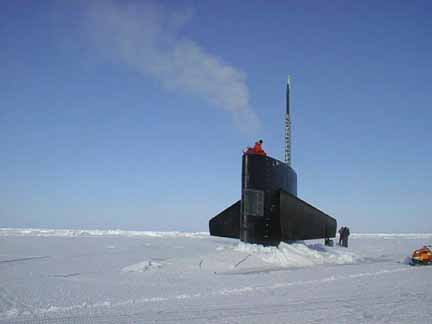
While the ice canopy was still overhead, preventing a quick and easy excursion to periscope depth to communicate, exchange air or get a GPS fix, at least they were no longer in the equivalent of an ice straightjacket. But more, once a submarine crew has completed a submerged Bering Strait transit in winter, they have a confidence in their ship and themselves that will serve both individuals and country they have completed a difficult "trial by ice." Likely the first indication of deeper water to the "nukes" back aft (nuclear trained personnel) was the engine order telegraph ringing up an ahead two-thirds bell-finally they had a chance to put a few turns on. While somewhat isolated from the excitement (and stress) in the control room where the ship handling takes place, the 29° F water of the arctic has other engineering consequences. The chill of the exterior seawater causes the interior hull to drip water constantly from condensation, potentially placing both electronics and high-voltage breakers and buses at risk. In addition to placing plastic and insulation at strategic spots, freshwater piping in proximity to the hull gets electric heating tape and exterior tanks holding fresh water get brine added to reduce the freezing point below 29°. 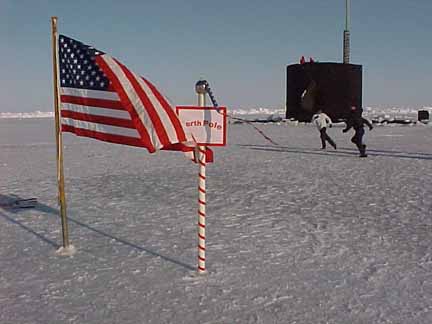
For a typical Ice Exercise or Science Ice Exercise, (ICEX, SCICEX), after entering the deep ocean basin the crew might have the prospect of working with am ice camp in the Beaufort Sea north of Alaska or in the Arctic Ocean northeast of Greenland. U.S. Navy-sponsored ice camps, with die installation of an acoustic tracking range, provide submarines the opportunity to conduct research and development with precise tracking information. Torpedo and sonar testing, dual ship operations and, almost always, one or more VIP trips are the types of events that frequently occur. During Ice Camp Lyon (named to commemorate the founder of the Arctic Submarine Laboratory, Dr. Waldo K Lyon) that took place in April 1999 the following officials took the opportunity to experience submarine operations up close" aboard Hawkbill, the Deputy Secretary of Defense, John Hammre the head of the National Science Foundation, Dr. Rita Colwell; the Secretary of the Navy, Richard Danzig; the Chief of Naval Operations, Adm. Jay Johnson; the Director of Naval Nuclear Propulsion, Adm. Frank 'Skip' Bowman; Sen. Chuck Robb, and Commander, Submarine Force, U.S. Pacific Fleet, Adm. Al Kosnetzni, among others. Other science events that took place included; Arctic climate observations using underwater sound (ACOUS), the successful receipt of a 20-Hz acoustic sent From a source off Franz Joseph Land measuring ocean temperature and mass structure; the first successful trial of a prototype ice-penetrating buoy through more than one meter of ice; acquisition of temperature and salinity profiles in the water column ice analysis ground-truth studies; measurement of small-scale variations in current, salinity, and temperature just beneath the ice cover to monitor near-surface heat flux; and deployment of a meteorological buoy for the International Arctic Buoy program. 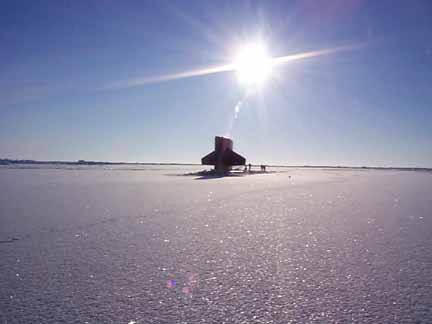
How does a nuclear submarine surface up through the ice? It's part of the reason that the job of ice pilot exists, because the maneuver requires the coordination of several critical actions, precise ship handling and exquisite timing in a framework of dynamic movement of both ship and ice. First, the submarine must find a "surfaceable feature" amid the ridges, blocks, and slabs of Frozen seawater that makes up the arctic ice canopy. The simplest form of surfaceable feature is open water-a fairly frequent occurrence, especially in the summer when wind and weather force the ice to separate. Remember that wind is what moves the ice. Open water is usually a second choice. because after surfacing the submarine must then maneuver to come alongside an ice floe, put across a brow (small bridge) to get on the ice, and then put over lines to deadmen placed in holes drilled into the ice. Experience has shown that damage to the submarine is more likely in an open-water arm (called a polynya) than when surfacing through the ice, where ship's position is, by definition, fixed. Think of maneuvering a 300-foot, single-screw ship in an uncharted, never-before-seen, irregularly shaped, concrete-lined harbor that's moving. Preferable is a polynya that has had a couple of days to freeze over to a thickness of 12 to 18 inches. An upward-looking side sonar, installed by the Arctic Submarine Laboratory (ASL) prior to deployment, is the sensor of choice for the detection of either open water or a recently frozen flat sheet of sea ice. Once a surfaceable feature has been detected, the submarine most map it out by rowersing the ams, from different points. In preparation for surfacing, the submarine rises to a more shallow, depth, about 200 feet, and makes other preparations to surface, such as placing the fairwater planes in the vertical position. The final approach is made at about one knot in order to stop the ship without overrunning the feature-now things get tricky. 
With the wind moving the ice at up to a knot and currents moving the submarine at up to half a knot, usually not in the same direction, the timeliness of ship positioning, stopping, and ascending to the ice (vertical surfacing) is critical. Once stopped, an upward-looking video camera mounted in the sail (also installed by ASQ gives an indication of ship's movement relative to the ice. The commanding officer (CO) orders the conning officer to commence a slow vertical ascent and raises a periscope for a quick look around to confirm that them are no close ice keels. Once the periscope is down and he's satisfied that everything is ready, the CO orders the conning officer to vertically surface the ship. Ahh-ooog-ahhh, ahh-ooog-ahhh, sounds the ship's diving alarm and "Vertical surface, vertical surface, vertical surface" is announced by the chief of the watch over the ships general announcing system. The diving officer has already trimmed the ship for a slight up-angle (to concentrate force on the trading edge of the sail) and now orders more ballast pumped out in order to increase the ascent rate. He has a stopwatch in his hand and reports keel depth and ascent rate every 10 feet. Adrenaline has everyone time sense dilated, and the submarine seems to take forever to get up to the ice. In the critical phase of the ascent, between the keel depth of 100 feet and impact with the ice at about 60 feet, the upward-looking camera, the sidescan sonar, and the ahead-look sonar are useless with respect to indicating whether the ship is standing into danger. The only sensor that will indicate whether the bow or stern has swung under an ice keel is a 1950s-era low-Frequency, wide-angle sonar, mounted on bow and stern, mechanically printing out on smelly thermal paper. Sometimes the old stuff still works best. 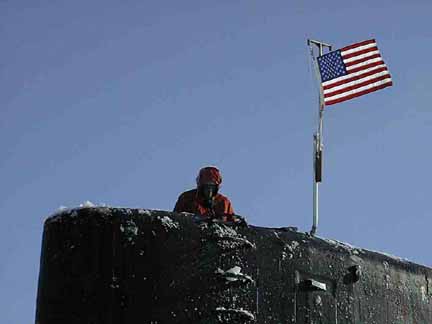
Impact is indicated by a soft crunching sound over the upper underwater telephone hydrophone and the forward-look sonar screen blinking red-"Blow forward" And the sound of high-pressure air displacing water in the forward main ballast tanks (MBTs) shudders through the ship. All eyes are on the bubble (ships pitch indicator) because too high an angle will slam the fiberglass dome surrounding the ship's main sonar sphere into the ice. "Blow aft!" and the ship shudders again, but no one's eyes move because now the risk is a negative angle and slamming the ships screw into the ice. It's a delicate balancing act that requires exactly the right orders at exactly the right time carried tied our by highly skilled professionals. After each release, of compressed air, the chief petty officer on the sound-powered phones sings out the resultant air bank pressure and the limiting pressure that equates to the limit of the total amount of water that can safely be displaced from the MBTs. Too much, and the center of buoyancy will drop below the center of gravity and the submarine will become unstable and possibly roll 90° to port or starboard producing an air bubble in the MBTs that can't be removed. But, assuming that the ice isn't too thick, which surprisingly little shock or fuss the submarine will break the ice and resume its ascent until fully surfaced. Sometimes the only way the crew on board can tell the sub has broken through is by watching the depth gauge. For an observer on the ice overhead, it's a different story, however, as the following description From the surfacing of Hawkbill at Ice Camp Lyon shows: 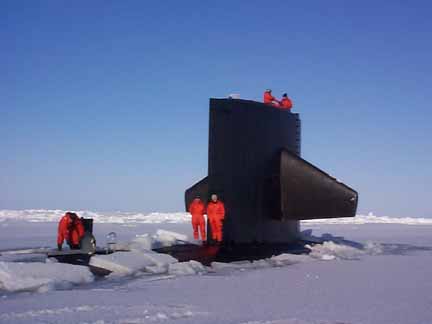
"The image was set to bring together Hawkbill and our arctic visitors in an awesome display of shattered blue-green ice thrown 30 feet into the air by a shark-black glistening steel predator. The initial impact of 5,000 tons of nuclear propulsion, radiation shielding, electronics, officers, and crew: wrapped in two inches of high-strength steel (HY-80) lifts the entire ice flower-encrusted sheet of two-week-old ice before it splits and the reinforced sail emerges. Hawkbill cracks the flat pan of ice its entire length (500 yds). All is well. With the sun having barely risen, seawater runs off Hawkbill's crimson reflecting sail as ice chunks fall with a thump. While the outline of the hull can be seen in the rounded rim of the ice, only the sail actually penetrates through the ice. Hawkbill has arrived." |
